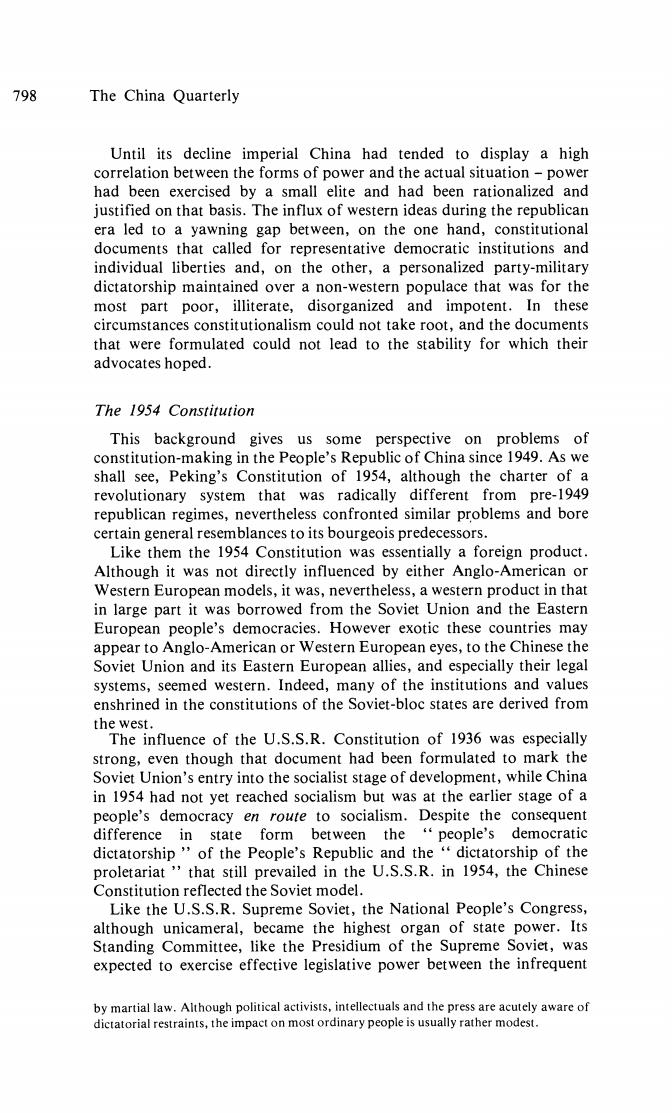正在加载图片...

798 The China Quarterly Until its decline imperial China had tended to display a high correlation between the forms of power and the actual situation -power had been exercised by a small elite and had been rationalized and justified on that basis.The influx of western ideas during the republican era led to a yawning gap between,on the one hand,constitutional documents that called for representative democratic institutions and individual liberties and,on the other,a personalized party-military dictatorship maintained over a non-western populace that was for the most part poor,illiterate,disorganized and impotent.In these circumstances constitutionalism could not take root,and the documents that were formulated could not lead to the stability for which their advocates hoped. The 1954 Constitution This background gives us some perspective on problems of constitution-making in the People's Republic of China since 1949.As we shall see,Peking's Constitution of 1954,although the charter of a revolutionary system that was radically different from pre-1949 republican regimes,nevertheless confronted similar problems and bore certain general resemblances to its bourgeois predecessors. Like them the 1954 Constitution was essentially a foreign product. Although it was not directly influenced by either Anglo-American or Western European models,it was,nevertheless,a western product in that in large part it was borrowed from the Soviet Union and the Eastern European people's democracies.However exotic these countries may appear to Anglo-American or Western European eyes,to the Chinese the Soviet Union and its Eastern European allies,and especially their legal systems,seemed western.Indeed,many of the institutions and values enshrined in the constitutions of the Soviet-bloc states are derived from the west. The influence of the U.S.S.R.Constitution of 1936 was especially strong,even though that document had been formulated to mark the Soviet Union's entry into the socialist stage of development,while China in 1954 had not yet reached socialism but was at the earlier stage of a people's democracy en route to socialism.Despite the consequent difference in state form between the "people's democratic dictatorship"'of the People's Republic and the"dictatorship of the proletariat''that still prevailed in the U.S.S.R.in 1954,the Chinese Constitution reflected the Soviet model. Like the U.S.S.R.Supreme Soviet,the National People's Congress, although unicameral,became the highest organ of state power.Its Standing Committee,like the Presidium of the Supreme Soviet,was expected to exercise effective legislative power between the infrequent by martial law.Although political activists,intellectuals and the press are acutely aware of dictatorial restraints,the impact on most ordinary people is usually rather modest.The China Quarterly Until its decline imperial China had tended to display a high correlation between the forms of power and the actual situation - power had been exercised by a small elite and had been rationalized and justified on that basis. The influx of western ideas during the republican era led to a yawning gap between, on the one hand, constitutional documents that called for representative democratic institutions and individual liberties and, on the other, a personalized party-military dictatorship maintained over a non-western populace that was for the most part poor, illiterate, disorganized and impotent. In these circumstances constitutionalism could not take root, and the documents that were formulated could not lead to the stability for which their advocates hoped. The 1954 Constitution This background gives us some perspective on problems of constitution-making in the People's Republic of China since 1949. As we shall see, Peking's Constitution of 1954, although the charter of a revolutionary system that was radically different from pre- 1949 republican regimes, nevertheless confronted similar problems and bore certain general resemblances to its bourgeois predecessors. Like them the 1954 Constitution was essentially a foreign product. Although it was not directly influenced by either Anglo-American or Western European models, it was, nevertheless, a western product in that in large part it was borrowed from the Soviet Union and the Eastern European people's democracies. However exotic these countries may appear to Anglo-American or Western European eyes, to the Chinese the Soviet Union and its Eastern European allies, and especially their legal systems, seemed western. Indeed, many of the institutions and values enshrined in the constitutions of the Soviet-bloc states are derived from the west. The influence of the U.S.S.R. Constitution of 1936 was especially strong, even though that document had been formulated to mark the Soviet Union's entry into the socialist stage of development, while China in 1954 had not yet reached socialism but was at the earlier stage of a people's democracy en route to socialism. Despite the consequent difference in state form between the " people's democratic dictatorship " of the People's Republic and the " dictatorship of the proletariat " that still prevailed in the U.S.S.R. in 1954, the Chinese Constitution reflected the Soviet model. Like the U.S.S.R. Supreme Soviet, the National People's Congress, although unicameral, became the highest organ of state power. Its Standing Committee, like the Presidium of the Supreme Soviet, was expected to exercise effective legislative power between the infrequent by martial law. Although political activists, intellectuals and the press are acutely aware of dictatorial restraints, the impact on most ordinary people is usually rather modest